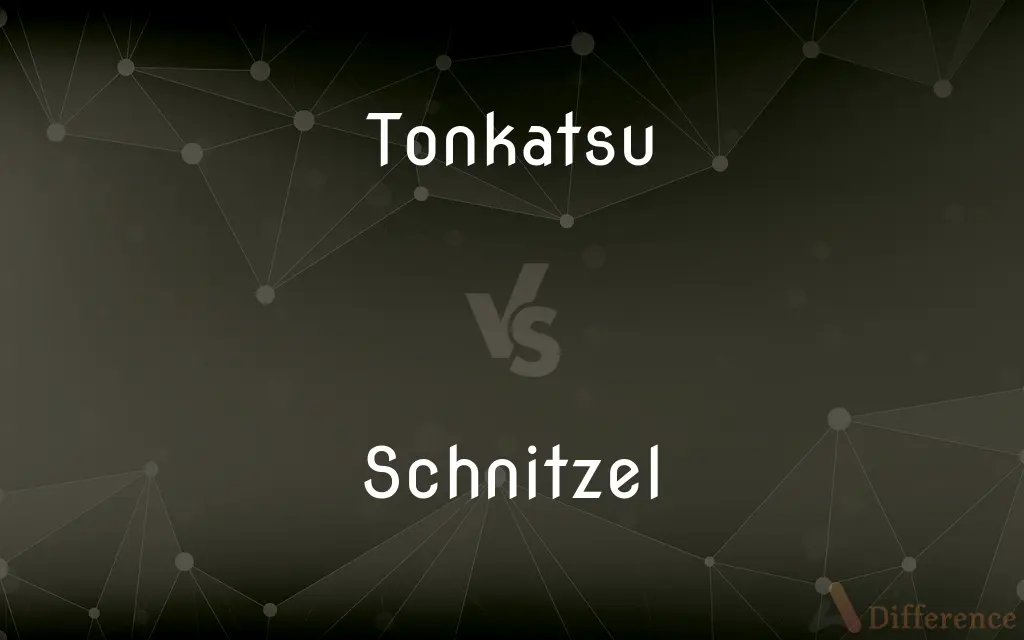Tonkatsu vs. Schnitzel — What's the Difference?
Edited by Tayyaba Rehman — By Fiza Rafique — Updated on April 15, 2024
Tonkatsu is a Japanese deep-fried breaded pork cutlet, often served with cabbage and sauce, while Schnitzel is a breaded, pan-fried cutlet that can be made from various meats and is a staple in Austrian and German cuisine.

Difference Between Tonkatsu and Schnitzel
Table of Contents
ADVERTISEMENT
Key Differences
Tonkatsu is traditionally made from pork loin or tenderloin, coated in panko breadcrumbs for a light, crispy texture. In contrast, Schnitzel is typically prepared using veal, pork, chicken, or turkey and is breaded with regular breadcrumbs, which give it a denser, crunchier crust.
Tonkatsu is deep-fried, leading to a juicy interior and a fluffy, crisp exterior. On the other hand, Schnitzel is pan-fried, which results in a less oily finish and a firmer texture.
In Japan, Tonkatsu is commonly served with a thick, sweet sauce known as Tonkatsu sauce, along with shredded cabbage and rice. Meanwhile, Schnitzel is often accompanied by lemon slices, lingonberry jam, and potatoes or salad, highlighting the varied accompaniments that reflect regional tastes.
Tonkatsu is an essential part of Japanese cuisine, often found in bento boxes or as part of a set meal in restaurants. Whereas Schnitzel is deeply embedded in Austrian and German traditions, frequently featured in festive and daily meals.
While Tonkatsu has been embraced globally in various adaptations, such as in sandwiches and curry dishes, Schnitzel remains closely associated with its traditional presentations and is celebrated in numerous European festivals and culinary competitions.
ADVERTISEMENT
Comparison Chart
Origin
Japanese
Austrian/German
Meat Used
Pork loin or tenderloin
Veal, pork, chicken, or turkey
Cooking Method
Deep-fried
Pan-fried
Breadcrumbs Type
Panko (light, flaky)
Regular (denser, crunchier)
Typical Sides
Cabbage, rice, Tonkatsu sauce
Lemon, lingonberry jam, potatoes
Compare with Definitions
Tonkatsu
Japanese dish of breaded, deep-fried pork cutlet.
Tonkatsu is often eaten with a side of shredded cabbage.
Schnitzel
Breaded, pan-fried cutlet popular in Austrian and German cuisine.
He enjoyed a veal Schnitzel with a slice of lemon.
Tonkatsu
Made using panko breadcrumbs for a lighter crust.
The Tonkatsu had a perfectly crispy panko crust.
Schnitzel
Often made from veal, known as Wiener Schnitzel.
Wiener Schnitzel is a must-try dish in Vienna.
Tonkatsu
Often included in bento boxes.
Her bento featured a mini Tonkatsu alongside other sides.
Schnitzel
Served with a variety of sides such as potatoes and salad.
The Schnitzel came with a side of German potato salad.
Tonkatsu
Typically served with rice and Tonkatsu sauce.
He ordered a Tonkatsu set meal which included miso soup.
Schnitzel
Can be made from pork, chicken, or turkey.
She ordered a chicken Schnitzel for dinner.
Tonkatsu
Can be used in other dishes like Tonkatsu curry.
Tonkatsu curry is a popular comfort food in Japan.
Schnitzel
Typically accompanied by lingonberry jam in northern Europe.
He spread lingonberry jam over his Schnitzel.
Tonkatsu
Tonkatsu (豚カツ, とんかつ or トンカツ, pronounced [toŋkatsɯ]; "pork cutlet") is a Japanese dish that consists of a breaded, deep-fried pork cutlet. It involves coating slices of pork with panko (bread crumbs), and then frying them in oil.
Schnitzel
A schnitzel is a thin slice of meat. The meat is usually thinned by pounding with a meat tenderizer.
Tonkatsu
A popular Japanese dish consisting of a breaded, deep-fried pork cutlet served in bite-sized pieces and often accompanied by shredded cabbage and miso soup.
Schnitzel
A thin cutlet of veal or other meat, usually seasoned, that is dipped in batter and fried.
Schnitzel
A dish consisting of fried veal cutlet.
Schnitzel
(by extension) A Germanic dish of breaded and deep-fried meat cutlet.
Schnitzel
Deep-fried breaded veal cutlets
Common Curiosities
How is Tonkatsu typically served?
It is usually served with shredded cabbage, rice, and Tonkatsu sauce.
What is a traditional side for Schnitzel?
Traditional sides include potatoes, salad, and sometimes lingonberry jam.
What is Tonkatsu?
Tonkatsu is a Japanese dish featuring a breaded, deep-fried pork cutlet.
How do the cooking methods of Tonkatsu and Schnitzel differ?
Tonkatsu is deep-fried, whereas Schnitzel is pan-fried.
What meats can be used to make Schnitzel?
Schnitzel can be made from veal, pork, chicken, or turkey.
Can Tonkatsu be made with meat other than pork?
While traditionally made with pork, some variations might use chicken.
Is Tonkatsu ever served without its typical sides?
Rarely, as it is almost always accompanied by cabbage and often rice.
How do serving styles of Tonkatsu and Schnitzel reflect their cultures?
Tonkatsu's serving with rice and sauce reflects Japanese tastes, whereas Schnitzel's accompaniments like potatoes and salad reflect European dietary preferences.
What makes the breading of Schnitzel different from Tonkatsu?
Schnitzel uses regular breadcrumbs, while Tonkatsu uses lighter, flakier panko breadcrumbs.
Is there a vegetarian version of Schnitzel?
Yes, there are vegetarian versions that use substitutes like soy or seitan.
What sauces typically accompany Tonkatsu and Schnitzel?
Tonkatsu is served with a sweet Tonkatsu sauce; Schnitzel often has no sauce but may come with lemon or jam.
Are there any common variations of Schnitzel in different countries?
Yes, countries like Italy and Israel have their versions, such as Cotoletta and Schnitzel, respectively.
What are the essential ingredients for making Schnitzel?
Essential ingredients include the meat of choice, breadcrumbs, eggs, flour, and seasoning.
What is the origin of Tonkatsu?
Tonkatsu originated in Japan as a variation of Western dishes in the 19th century.
Can Schnitzel be deep-fried like Tonkatsu?
It's uncommon as Schnitzel is traditionally pan-fried for a less oily finish.
Share Your Discovery

Previous Comparison
Issue vs. Promulgate
Next Comparison
Noughty vs. NaughtyAuthor Spotlight
Written by
Fiza RafiqueFiza Rafique is a skilled content writer at AskDifference.com, where she meticulously refines and enhances written pieces. Drawing from her vast editorial expertise, Fiza ensures clarity, accuracy, and precision in every article. Passionate about language, she continually seeks to elevate the quality of content for readers worldwide.
Edited by
Tayyaba RehmanTayyaba Rehman is a distinguished writer, currently serving as a primary contributor to askdifference.com. As a researcher in semantics and etymology, Tayyaba's passion for the complexity of languages and their distinctions has found a perfect home on the platform. Tayyaba delves into the intricacies of language, distinguishing between commonly confused words and phrases, thereby providing clarity for readers worldwide.















































